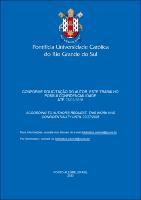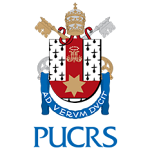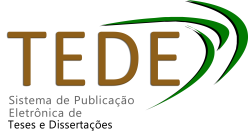| Share record |


|
Please use this identifier to cite or link to this item:
https://tede2.pucrs.br/tede2/handle/tede/10646Full metadata record
| DC Field | Value | Language |
|---|---|---|
| dc.creator | Almeida, Kalil Sauaia Boahid Mello | - |
| dc.creator.Lattes | http://lattes.cnpq.br/8133692269829800 | por |
| dc.contributor.advisor1 | Jobim, Marco Félix | - |
| dc.contributor.advisor1Lattes | http://lattes.cnpq.br/7781138223264118 | por |
| dc.date.accessioned | 2023-02-27T19:09:42Z | - |
| dc.date.issued | 2022-11-18 | - |
| dc.identifier.uri | https://tede2.pucrs.br/tede2/handle/tede/10646 | - |
| dc.description.resumo | O tema do presente trabalho é a relação entre os precedentes e o Superior Tribunal de Justiça (STJ). O problema de pesquisa é a análise da função institucional do STJ diante do estabelecimento do sistema de precedentes no Código de Processo Civil de 2015 (CPC/2015). O objetivo geral é analisar a função do STJ, diante do quadro normativo que estabelece os precedentes como forma de promoção da unidade do direito. Em específico: a) definir os pressupostos teóricos que propiciam a leitura adequada dos temas; b) verificar possível transformação da função institucional do STJ ao longo do tempo em razão de mudanças doutrinárias e reformas legislativas; c) estudar o papel do sistema de precedentes previsto no CPC/2015 na promoção da unidade do direito; d) analisar a melhor interpretação da função institucional do STJ e o grau de preponderância das facetas de resolução de casos concretos e unificação da interpretação jurídica. A metodologia adotada é exploratória através da análise de textos legais, precedentes e da doutrina pertinente. O método strictu sensu é o hipotético dedutivo. Os resultados da pesquisa demonstram que os pressupostos necessários são a adoção do ceticismo moderado, da tese de dupla necessidade discursiva do processo civil e a ideia de influxo misto de tradições. Também se constata a transformação da função do STJ após a sua instituição na CRFB/1988, o marco desta mudança é o estabelecimento da Súmula vinculante na EC nº 45/2004. Em seguida foi possível comprovar que o alcance do sistema de precedentes não está limitado à lista do art. 927 do CPC/2015. Ao final, é possível reconhecer o STJ como Corte Suprema, responsável pela promoção da unidade do direito. | por |
| dc.description.abstract | The theme of the present work is the relationship between precedents and the “Superior Tribunal de Justiça (STJ)”. The research problem is the analysis of the institutional role of the STJ in view of the establishment of the precedents system in the Civil Procedure Code of 2015 (CPC/2015). The general objective is to analyze the role of the STJ given the normative framework that establishes precedents as a way of promoting the unity in law. Specifically: a) to define the theoretical assumptions that provide the proper reading of the themes; b) to verify possible transformation of the institutional function of the STJ over time due to doctrinal changes and legislative reforms; c) to study the role of the precedents system provided in CPC/2015 on promotion of unity in law; d) to analyze the best interpretation of the institutional function of the STJ and the degree of preponderance of the facets of resolution of concrete cases and unification of the legal interpretation. The methodology adopted is exploratory through the analysis of legal texts, precedents and the pertinent doctrine. The strictu sensu method is the hypothetical deductive method. The research results demonstrate that the necessary assumptions are the adoption of moderate skepticism, the thesis of double discursive necessity of the civil process and the idea of mixed influx of traditions. The transformation of the role of the STJ after its institution in the CRFB/1988 can also be seen and the landmark of this change is the establishment of the “Súmula vinculante” in EC nº 45/2004. Then it was possible to prove that the scope of the precedents system is not limited to the list of art. 927 of the CPC/2015. In the end, it is possible to recognize the STJ as a Supreme Court responsible for promoting the unity in law. | eng |
| dc.description.provenance | Submitted by PPG Direito ([email protected]) on 2023-02-17T18:54:12Z No. of bitstreams: 1 KALIL_ SAUAIA_ BOAHID_ MELLO_ ALMEIDA_DIS.pdf: 1799827 bytes, checksum: a220a90664f7b5605f94335d2bd46de8 (MD5) | eng |
| dc.description.provenance | Approved for entry into archive by Sheila Dias ([email protected]) on 2023-02-27T19:01:36Z (GMT) No. of bitstreams: 1 KALIL_ SAUAIA_ BOAHID_ MELLO_ ALMEIDA_DIS.pdf: 1799827 bytes, checksum: a220a90664f7b5605f94335d2bd46de8 (MD5) | eng |
| dc.description.provenance | Made available in DSpace on 2023-02-27T19:09:42Z (GMT). No. of bitstreams: 1 KALIL_ SAUAIA_ BOAHID_ MELLO_ ALMEIDA_DIS.pdf: 1799827 bytes, checksum: a220a90664f7b5605f94335d2bd46de8 (MD5) Previous issue date: 2022-11-18 | eng |
| dc.format | application/pdf | * |
| dc.thumbnail.url | https://tede2.pucrs.br/tede2/retrieve/186608/DIS_KALIL_SAUAIA_BOAHID_MELLO_ALMEIDA_CONFIDENCIAL.pdf.jpg | * |
| dc.language | por | por |
| dc.publisher | Pontifícia Universidade Católica do Rio Grande do Sul | por |
| dc.publisher.department | Escola de Direito | por |
| dc.publisher.country | Brasil | por |
| dc.publisher.initials | PUCRS | por |
| dc.publisher.program | Programa de Pós-Graduação em Direito | por |
| dc.rights | Acesso Aberto | por |
| dc.subject | Cortes Supremas | por |
| dc.subject | Precedentes | por |
| dc.subject | Unidade do Direito | por |
| dc.subject | Acesso às Cortes Supremas | por |
| dc.subject | Supreme Courts | eng |
| dc.subject | Precedents | eng |
| dc.subject | Unity in Law | eng |
| dc.subject | Access to the Supreme Courts | eng |
| dc.subject.cnpq | CIENCIAS SOCIAIS APLICADAS::DIREITO | por |
| dc.title | Precedentes e unidade do direito no Superior Tribunal de Justiça : da CRFB/1988 ao CPC/2015 | por |
| dc.type | Dissertação | por |
| dc.restricao.situacao | Trabalho será publicado como artigo ou livro | por |
| dc.restricao.prazo | 60 meses | por |
| dc.restricao.dataliberacao | 27/02/2028 | por |
| Appears in Collections: | Programa de Pós-Graduação em Direito | |
Files in This Item:
| File | Description | Size | Format | |
|---|---|---|---|---|
| DIS_KALIL_SAUAIA_BOAHID_MELLO_ALMEIDA_CONFIDENCIAL.pdf | KALIL_SAUAIA_BOAHID_MELLO_ALMEIDA_DIS | 602.19 kB | Adobe PDF |  Download/Open Preview |
Items in DSpace are protected by copyright, with all rights reserved, unless otherwise indicated.




